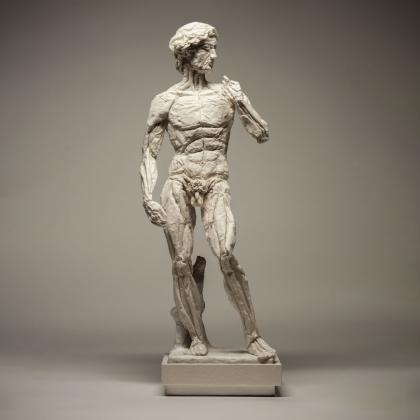This model is based on Boice's sculpture base, "Looking beyond", which is inspired by one of the most famous sculptures in the world, "David" by Michelangelo (1475–1564). David is the culmination of my shaping experiments for the last 2 1/2 years which have been heavily influenced by Eric Joisel's artistic approach.
For this fold, not only did I want to recreate the statue of David as closely as possible, I also wanted to dive into hyperrealism by emphasizing the anatomical structure in order to capture the beauty of the human body. Since it was important to me to communicate just how monumental Michelangelo's David was, I tried to elevate the paper texture through traditional sculpting methods to create organic, human shapes. By carefully moulding the various skeletal muscle groups that form David's body, I wanted to explore what lies beneath the surface of David's anatomy.
This unusual level of realism in origami has provoked people's understanding of what origami is and can be. Is it made from one square of paper, uncut, with no tears? Yes. Can it still be considered origami if the creation process adheres to those rules but the result looks more like papier-mâché (or some other traditional art form) and can it be both? Well, that really depends on who you ask or how open they are to the idea of pushing the boundaries in origami. I greatly enjoyed engaging in the conversations that came out of this.
For this fold, not only did I want to recreate the statue of David as closely as possible, I also wanted to dive into hyperrealism by emphasizing the anatomical structure in order to capture the beauty of the human body. Since it was important to me to communicate just how monumental Michelangelo's David was, I tried to elevate the paper texture through traditional sculpting methods to create organic, human shapes. By carefully moulding the various skeletal muscle groups that form David's body, I wanted to explore what lies beneath the surface of David's anatomy.
This unusual level of realism in origami has provoked people's understanding of what origami is and can be. Is it made from one square of paper, uncut, with no tears? Yes. Can it still be considered origami if the creation process adheres to those rules but the result looks more like papier-mâché (or some other traditional art form) and can it be both? Well, that really depends on who you ask or how open they are to the idea of pushing the boundaries in origami. I greatly enjoyed engaging in the conversations that came out of this.
Creator:
Michael Nguyen
Category:
Figurative
Type:
Interpretation
Creation Date:

